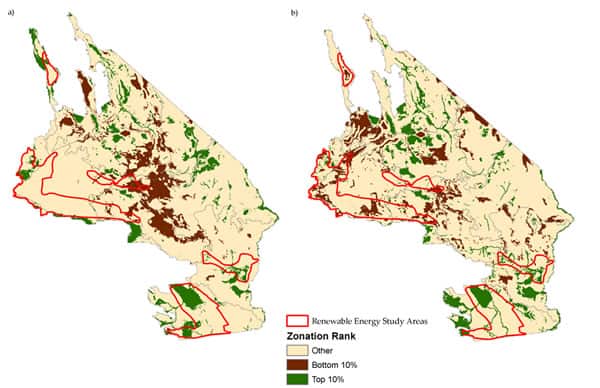PRBO Conservation Science (PRBO) recently completed a landscape prioritization analysis within the Desert Renewable Energy Conservation Plan (DRECP) planning area that identifies areas of high and low value to 66 breeding bird species and associated vegetation. Their analytical approach can be used to include other wildlife species for a more robust landscape prioritization.
Their results show that the DRECP planning area provides important habitat for birds, providing over 50% of the breeding range within California for at least 20 bird species. They identified the top 10% of the landscape in importance to the breeding bird community. These high value areas occurred throughout the DRECP planning area with a high percentage occurring in the Colorado Desert, Northern and South Eastern Mojave Desert, and the Sonoran Desert regions. High priority areas should be avoided for solar siting and should be incorporated into mitigation or land protection opportunities to benefit birds.
They also identified the lowest 10% of the landscape in importance to breeding birds. These low priority areas should be considered first for siting solar and other renewable energy installations to minimize impacts on breeding birds and included parts of the Mojave Desert.
Even low priority areas for birds supported over 30 species, suggesting they are providing worthwhile habitat for birds. In these cases, PRBO recommends site-specific surveys to assess their value prior to development.
On average, U.S. Fish and Wildlife Service lands in the DRECP planning area contain the highest priority areas of any other landowner. Managed open space lands, such as the majority of Bureau of Land Management Lands in the study region, had the lowest conservation value. The relatively high conservation value of unprotected lands, e.g., local and county jurisdictions, in the DRECP study area indicates that there are opportunities to acquire or place conservation easements on unprotected lands as part of renewable energy project mitigation.
These landscape prioritization results varied when researchers gave greater weight to sensitive species than to non-sensitive species, indicating that limiting analyses to sensitive bird species is not adequate to capture the breeding bird priority areas in the DRECP planning area. Further, species richness was a poor predictor of priority, suggesting that conservation decisions should not be based on species richness alone.
PRBO’s approach provides an important example of a rigorous priority-setting conservation planning exercise within the DRECP planning boundary (or in other settings) that could be extended to incorporate additional stakeholder data or information. Their results provide a data-rich and scientifically defensible means to determine high and low priority areas for breeding birds. However, they recommend that these results be used in concert with similar analyses that include additional bird species (e.g., wintering birds) as well as non-avian taxa, natural communities, and ecosystem services.
Full Report:
C. A. Howell and S. D. Veloz. 2011. Priority Areas for Breeding Birds within the Planning Area of the Desert Renewable Energy Conservation Plan. PRBO Technical Report. PRBO contribution #1823.

